|
GROWING up in my early childhood I was very much inspired by fairy tales, with illustrations of brightly coloured buildings with domes and curved shapes. I wondered where the inspiration from these buildings came from as they certainly weren’t anything like any of the buildings I had been familiar with in New Zealand. Forty years later I was to for the first time discover these fairy tale style buildings.
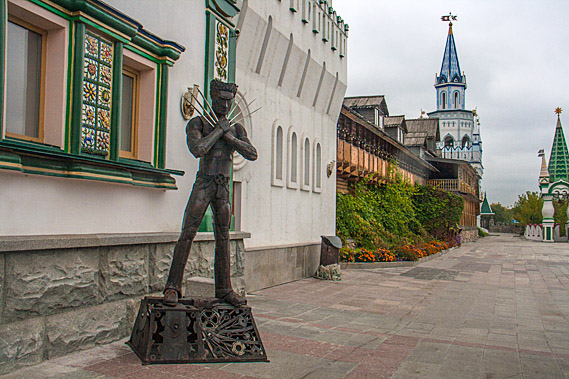 |
Statue at entrance |
The entrance into Izmailovo Kremlin led into a central square, where a large area of paving of large grey stones filled the areas between the buildings. Buildings occupied every space around the outside of the rectangular compound, and there were small clusters of buildings occupying some of the middle parts. The paving formed a very large figure of eight around the middle buildings.
 |
In the square |
Nothing was open now, but I knew that once the doors of these building do open, this complex will be swarming with crowds of people filtering out of the hotels mainly groups of tourists following their flag carrying leaders hurrying from store to store buying up big on souvenirs.
 |
St Nickolay's Church |
The most obvious building from inside the entrance was a towering dark timber St Nickolay’s Church with hardly a straight line as it waved its way several storeys high in the air to a conical tower holding up a relatively small crucifix. It is Russia’s highest wooden temple.
 |
Wooden building |
I followed the path heading anticlockwise around the church. To the right along the main wall were a set of souvenir shops all made from fancy log cabin style two store buildings. The timber in the logs still looked fairly new but the slats making up the angled roofing were greyed from age.
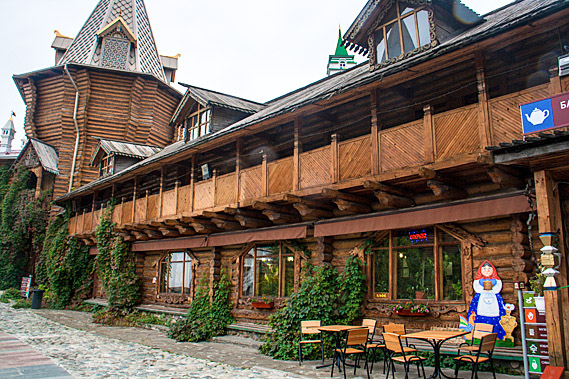 |
Cafe |
I met a lady exploring the area who saw my large camera and wanted her picture taken. I arranged for her to get mine done as well looking the other way back into the coloured buildings past the main entrance. Like me, she was just here to explore before the masses of tourists start arriving.
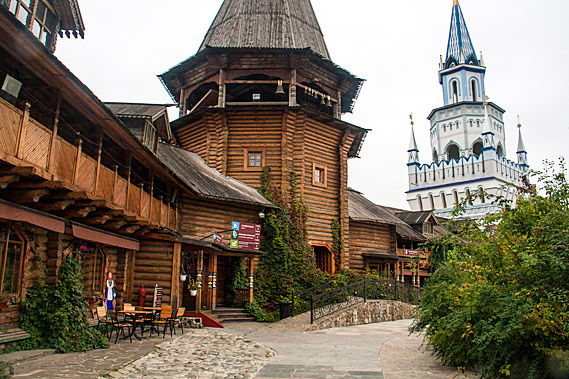 |
Cafe and watchtower |
Continuing along the paving, alternating pinkish grey and various shades of pure grey, I reached one building with a very elaborate staircase going across the side of the building with its own angled roof. This was the spa and wellness centre. I wondered what Russian massages were like. Were they similar to the ones over in South East Asia?
 |
Statue in gardens |
Nearby was a tall dark brown wooden octagonal building with faded orange trimming around the outside, almost giving the impression the building was made of chocolate. This was the appropriately the museum of chocolate.
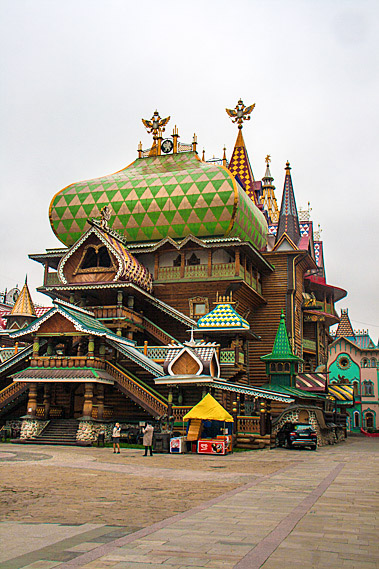 |
Fancy museum |
I was by now behind the church where a large grassy hill area landscaped a pond. A couple of white full-scale statues of people overlooked the garden. There was a bridge and a small gazebo set up as a photo area for couples. One small tree was covered in a rag tag of decorations almost looking like a scruffy Christmas tree that had the top half lopped off. This was the tree of happiness, supposedly for couples.
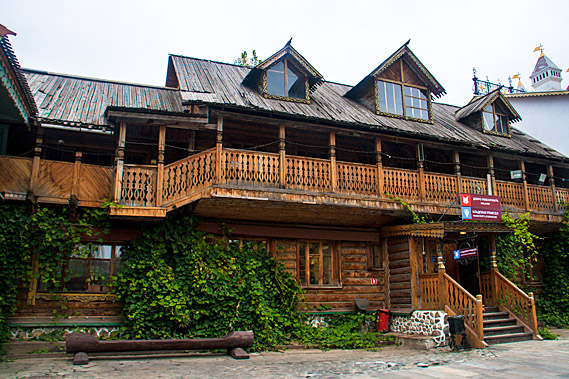 |
Restaurant |
The back of the church had a mass of ivy growing up the timber, slowly invading this otherwise pristine building as it clung onto the timber.
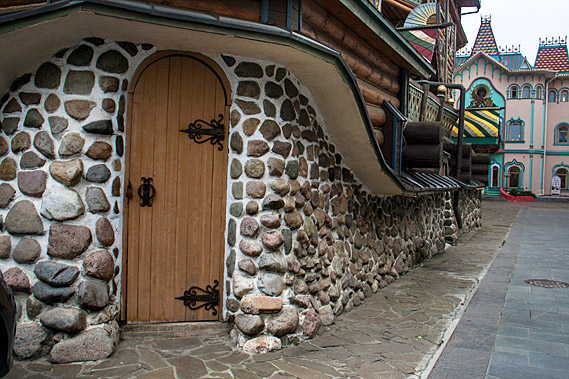 |
Door into basement |
At the corner was a large white tower with castle-like battlements and a small turret at each corner. This was the belfry viewpoint. Traditionally in kremlins this was the watchtower where guards are posted keeping watch for approaching invaders.
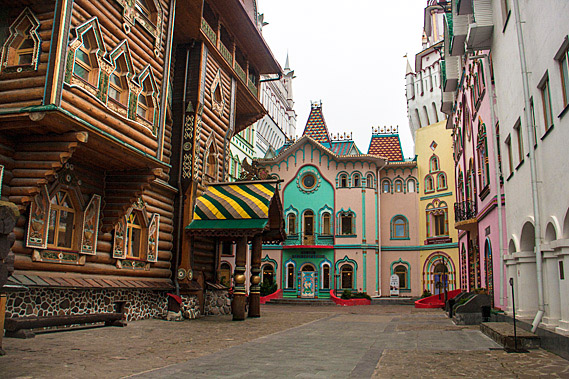 |
Street under colourful buildings |
A little further along was a café still closed up but ready for the coffee addicts coming soon. This was followed by a large craft shop.
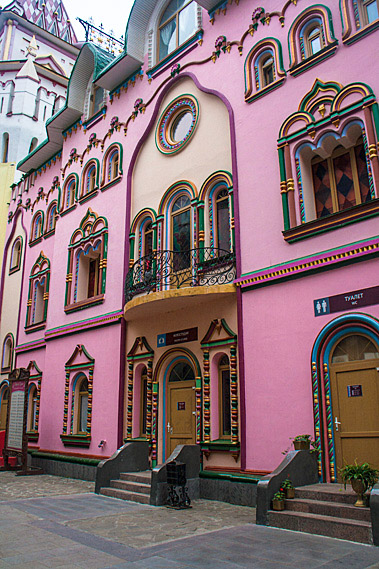 |
Pink museum |
Having gone full circle around the church I reached the central square again. Directly across from the church was a large three storey wooden building with a huge green and grey squared dome on top of it. This was the administration block. A couple of people were entering and exiting getting the complex ready for today’s crowds.
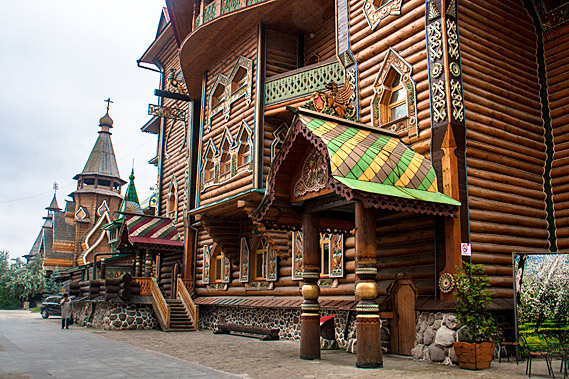 |
Fancy painting over timber |
I continued following the lane passing an elaborate wooden building containing the crafts store. Like many of the other buildings I had passed, it was constructed entirely of stained timber. The lower storey had large round logs. Upstairs a large verandah cantilevered above the lower storey. The verandah itself was largely obscured by the huge carved posts and fancy balustrades all made from solid stained timber. Grey timber slats made up the roof, steep for accumulated snow to fall off. The roof had three large gabled windows from the top storey.
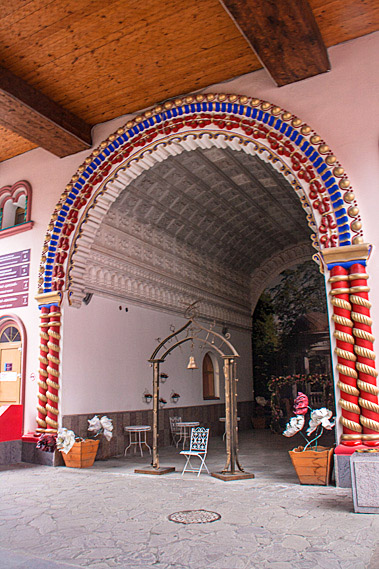 |
Chair under arch |
Beyond the café, the buildings around the outside of the complex were all rendered concrete painted in bright pastel colours.
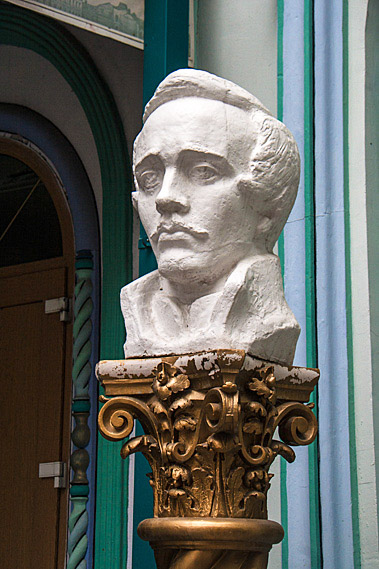 |
Bust |
The buildings in the middle were constructed from stone in the lower storey, and timber in the top two storeys. The large log cabin style was enhanced by bright pastel coloured trimmings in its very elaborate design. Rooms jutted out of the building in places. This end of the complex was very art deco.
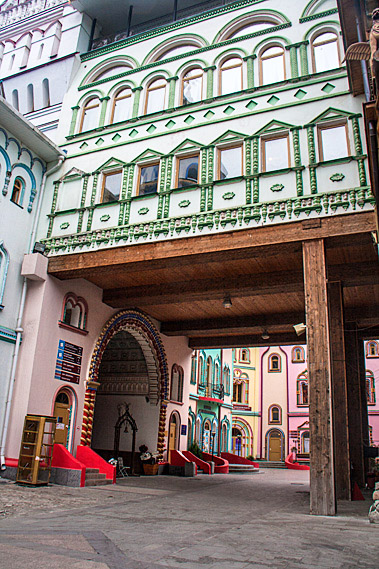 |
Building above street |
The buildings included a Russian Food Palace and a Pottery place. The building in the corner stood high as a white tower with a conical top.
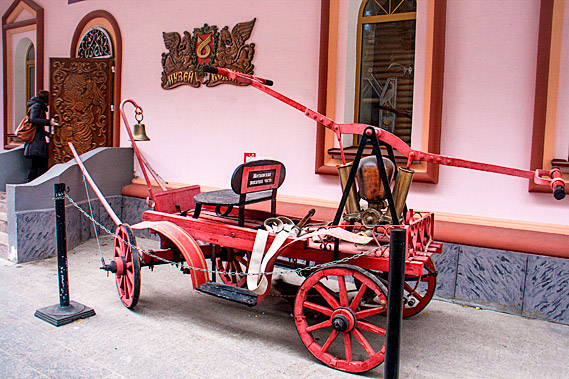 |
Small carriage |
Passing the corner, I reached an archway with a chair underneath it. A sign said this was the arch for photoshoots. I imagined when this place is full of tourists, there would be a few photographers at all the good spots charging for photos. A lot of local weddings take place here, local people wanting a very traditional Russian wedding.
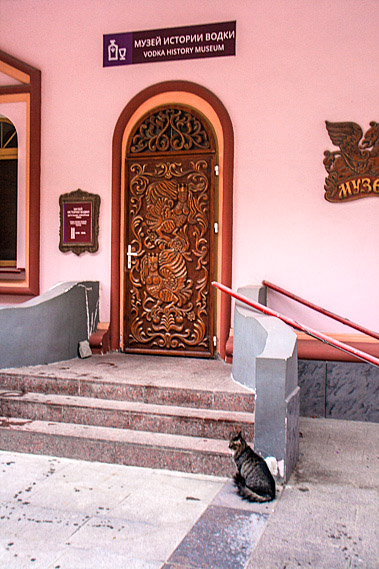 |
Vodka History Mus. |
Going around the next corner was a wedding shop. Around the corner was the Vodka history museum, where vodka tasting would take place. Vodka is a clear mixture of 60% water and 40% ethanol. There is little reliable history of the origins of vodka, but it probably came from Poland around the early middle ages, and was first brought to Moscow in 1386 from where it has since been made famous. Vodka these days is synonymous with Russia.
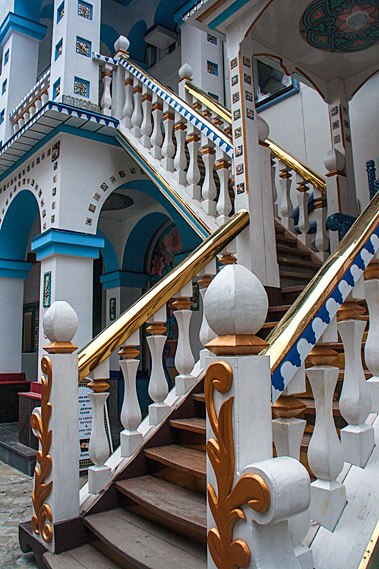 |
Fancy stairs |
Outside the Vodka History Museum was a tabby cat patiently waiting to be let in. Outside the pink museum were a couple of traditional carts and the bust of a famous Russian.
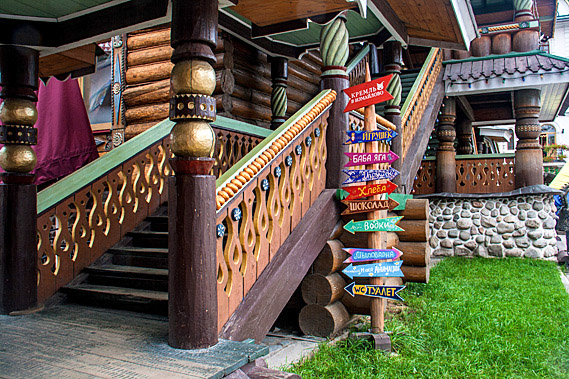 |
Fancy stairs |
I reached the main entrance, passing a couple of maps of the complex. A couple of small cart stalls were being set up and I could see the first of the crowds starting to arrive. I headed out passing the soldier statues and cannons and explored the outside buildings wondering where they would go to.
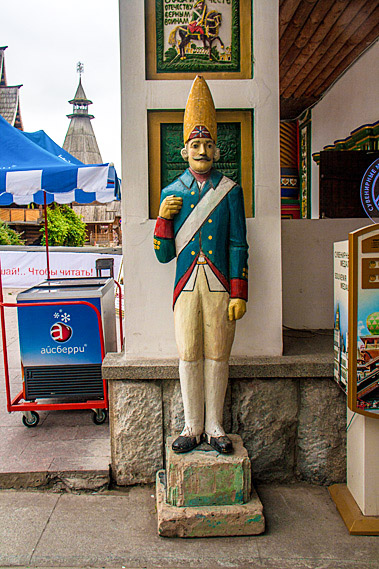 |
Soldier at entrance |
A wide cobblestone footpath led around the outside of the Izmailovo complex. The buildings had no exits out in this direction, but they were all elaborate timber buildings with ivy growing over them. Under the buildings were beds of bright orange and red marigolds.
 |
Cannon outside entrance |
Heading around past the lookout tower I reached a small stone gazebo with a huge two thirds scale gnome standing inside it. Once past the gazebo the bush obscuring the view beyond the complex cleared revealing a whole new section – the Vernissage in Izmailovo Territory. These were the markets, the largest in all of Russia.
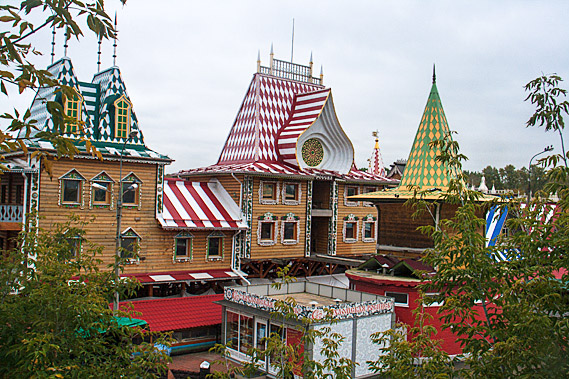 |
Vernissage in Izmailovo |
A cluster of buildings with light stained timber buildings capped with bright colour roofing and window trimmings laid out before me. The roofing of these buildings was very fancy, some with windows concealing a top storey.
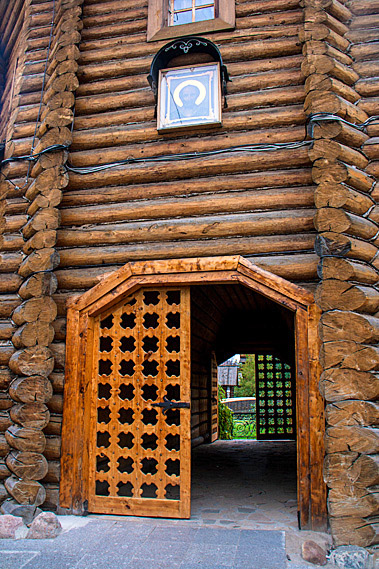 |
Gate through wall |
Passing behind the chocolate factory an open tunnel with huge wooden grid gates now open back into the Izmailovo Kremlin appeared, leading the way to the footbridge heading across the Vernissage.
 |
Vernissage in Izmailovo |
I crossed the footbridge seeing even more buildings below, including a large windmill. The footbridge went over a cluster of single storey buildings with purple brown roofing. These were the market stalls.
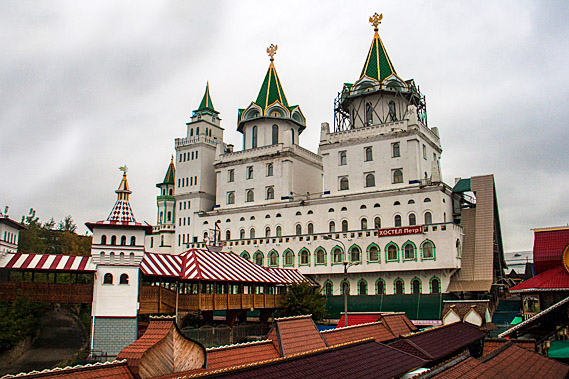 |
Vernissage in Izmailovo |
There was already a flurry of activity around the stalls with the traders setting up for the day. A bit of rain was now falling, so they were putting up plastic tarpaulins to keep the alleyways and their stock clean.
 |
Vernissage in Izmailovo |
From the bridge I could finally see the park, which had escaped view since the hotel. The deciduous trees were starting to go yellow with the autumn fall. The fall was running a few weeks later than I had seen across Siberia and Mongolia, with its much colder climates and trees already brightly coloured with the fall, or in some areas, with the trees having completely lost their leaves. Although Moscow suffered cold winters, they were very mild compared to the extreme conditions experienced in the vast lowlands of Siberia and the mountain highlands of Mongolia. The Gobi Desert and Tibet trap the cold air blowing in from the Arctic, making those areas amongst the coldest in the world. This side of Russia doesn’t have those natural barriers, so the winters here are not as harsh.
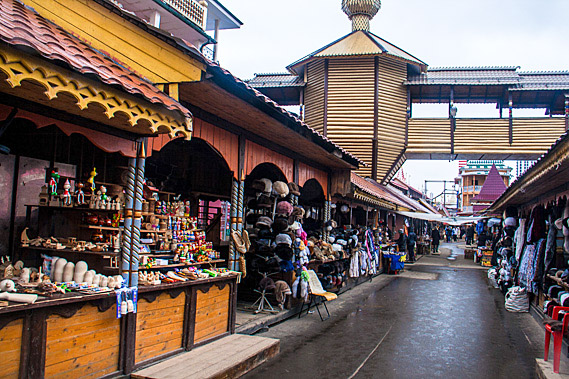 |
Markets |
A beautiful arched bridge crossed the neck of a sweeping lake at the base of the low rolling forested hills onto a forested artificial island where the palace of the Romanov family. I wanted to explore the enormous park but with my guide arriving soon, I had to return to the hotel.
I headed down a set of steps from the covered footbridge to the market stalls. The traders were still setting them up, but they were nearly complete. The quaint wooden stalls were packed with souvenirs including Russian doll sets, clothes made from furs, and everything else imaginable signifying Russia.
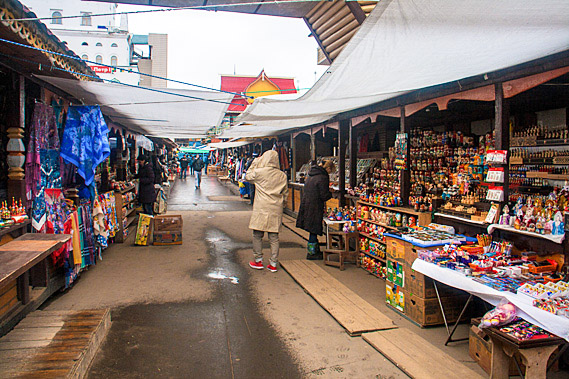 |
Markets |
With little time left I headed through the stalls back towards the front of the complex. I explored a couple of old cannons near the graded entrance, perhaps as a reminder of the original function of the Russian kremlins as military fortifications. They were painted in blues and whites, reds and yellows to match with the colourful complex.
With my guide for today due to arrive at the hotel foyer in a few minutes, I drew myself away from the fairy tale village heading back to the giant rectangular boxes of the hotel complex.
|
